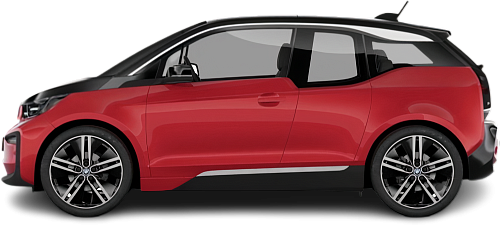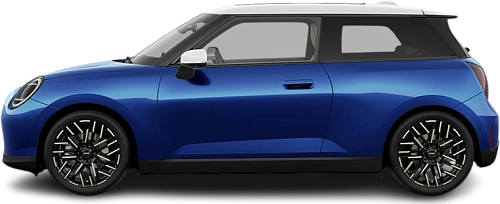Global EV Comparison: BMW i3s BEV 94 Ah vs Mini Cooper E
Struggling to Decide? Let AI Help!
Your AI Summary Is Ready!
General Info
The Mini Cooper E (2023-…) is currently produced, it has a starting price of €32900. The BMW i3s BEV 94 Ah (2017-2018) has been discontinued. You can find it for as low as €18125 on the used car market.
The two vehicles share the same body style: Hatchback.
| Property | BMW i3s BEV 94 Ah | Mini Cooper E |
|---|---|---|
| Years of Production | 2017-2018 | 2023-… |
| Current Status | Discontinued | Produced |
| Country of Manufacture | Germany | China |
| Body Style | Hatchback | Hatchback |
| Market Availability | EU, USA | EU |
| Price Europe (New) | - Price Europe (New) | €32900 |
| Price Europe (Used) | €18125 | €30999 |
| GCC Score | 5 | 5.3 |
Range and Efficiency
The Mini Cooper E (2023-…) boasts a greater real-world range, a larger battery, and superior energy efficiency compared to the BMW i3s BEV 94 Ah (2017-2018).
| Property | BMW i3s BEV 94 Ah | Mini Cooper E |
|---|---|---|
| Range (EPA) | 172 km | - Range (EPA) |
| Range (WLTP) | - Range (WLTP) | 307 km |
| Range (GCC) | 187 km | 262 km |
| Battery Capacity (Nominal) | 33.2 kWh | 40.7 kWh |
| Battery Capacity (Usable) | 27.2 kWh | 36.6 kWh |
| Efficiency per 100 km | 14.5 kWh/100 km | 14 kWh/100 km |
| Efficiency per kWh | 6.88 km/kWh | 7.16 km/kWh |
| Range and Efficiency Score | 5.8 | 6.5 |
Charging
Both vehicles utilize a standard 400-volt architecture.
The Mini Cooper E (2023-…) offers faster charging speeds at DC stations, reaching up to 70 kW, while the BMW i3s BEV 94 Ah (2017-2018) maxes out at 50 kW.
The Mini Cooper E (2023-…) features a more powerful on-board charger, supporting a maximum AC charging power of 11 kW, whereas the BMW i3s BEV 94 Ah (2017-2018) is limited to 7.4 kW.
| Property | BMW i3s BEV 94 Ah | Mini Cooper E |
|---|---|---|
| Max Charging Power (AC) | 7.4 kW | 11 kW |
| Max Charging Power (DC) | 50 kW | 70 kW |
| Architecture | 400 V | 400 V |
| Charge Port | CCS Type 2 | CCS Type 2 |
| Charging Score | 4 | 5.2 |
Performance
The BMW i3s BEV 94 Ah (2017-2018) is rear-wheel drive, while the Mini Cooper E (2023-…) offers a front-wheel drive system.
Both cars offer the same motor power, but the BMW i3s BEV 94 Ah (2017-2018) achieves a faster 0-100 km/h time.
| Property | BMW i3s BEV 94 Ah | Mini Cooper E |
|---|---|---|
| Drive Type | RWD | FWD |
| Motor Type | PMSM | PMSM |
| Motor Power (kW) | 135 kW | 135 kW |
| Motor Power (hp) | 181 hp | 181 hp |
| Motor Torque | 270 Nm | 290 Nm |
| 0-100 km/h | 6.9 s | 7.3 s |
| Top Speed | 160 km/h | 160 km/h |
| Performance Score | 3.5 | 3.5 |
Dimensions
The BMW i3s BEV 94 Ah (2017-2018) is longer and taller, but about the same width as the Mini Cooper E (2023-…).
Both models have similar wheelbase lengths.
| Property | BMW i3s BEV 94 Ah | Mini Cooper E |
|---|---|---|
| Length | 4006 mm | 3858 mm |
| Width (with Mirrors) | 2039 mm | 1967 mm |
| Width (w/o Mirrors) | 1791 mm | 1756 mm |
| Height | 1590 mm | 1460 mm |
| Wheelbase | 2570 mm | 2526 mm |
Cargo and Towing
The BMW i3s BEV 94 Ah (2017-2018) provides more cargo capacity, featuring both a larger trunk and more space with the rear seats folded.
Neither car is equipped with a frunk (front trunk).
Neither vehicle is officially rated for towing in in the EU.
| Property | BMW i3s BEV 94 Ah | Mini Cooper E |
|---|---|---|
| Number of Seats | 4 | 4 |
| Curb Weight | 1340 kg | 1500 kg |
| Cargo Volume (Trunk) | 260 l | 200 l |
| Cargo Volume (Max) | 1100 l | 800 l |
| Cargo Volume (Frunk) | - Cargo Volume (Frunk) | - Cargo Volume (Frunk) |
| Towing Capacity | - Towing Capacity | - Towing Capacity |
| Cargo and Towing Score | 4.3 | 3.6 |




